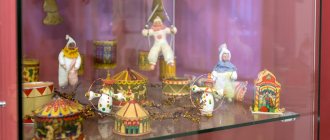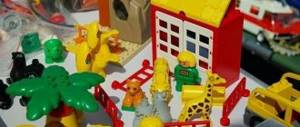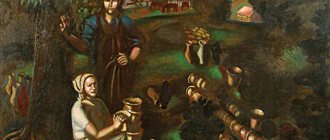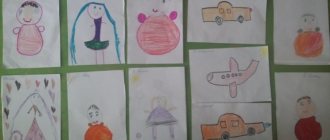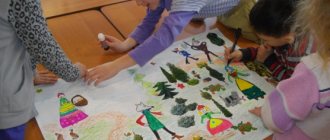The history of Bogorodsk wooden toys goes back more than 350 years. The products are known all over the world, and in their time they were appreciated not only by children, but also by world-famous sculptors. A distinctive feature of the Bogorodsk toy is the absence of obvious details and strict carved forms in sculptural products. Thanks to this manufacturing method, the toy developed creativity and imagination in children, and did not bother them for a long time.
Movable toys were no less interesting. Their thoughtful design worked for a long time and did not break.
The Bogorodskaya toy got its name from the village where craftsmen who made wooden blanks lived. The Bogorodsk toy became so firmly established in the life of the local population that one of the products became a symbol of the village and is depicted on its coat of arms. This is a moving toy with a man and a bear.
History of the fishery
The production of Bogorodsk toys began in the 15th – 16th centuries, in the village of the same name near Sergiev Posad, Moscow region. Initially, craftsmen in processing and artistic cutting of wood worked on orders from buyers. They prepared the base, which they then painted in Sergiev Posad.
Finally, as a craft, the production of Bogorodsk toys was formed at the end of the 18th - beginning of the 19th centuries, when the entire process of making toys was transferred to craftsmen from the village of Bogorodskoye. They developed them, determined the theme, made the bases and, if necessary, painted them.
At the beginning of the 20th century, an artel was organized in the same village, in which masters of cutting toys were trained, passing on to them the accumulated knowledge, techniques and skills. Due to the war and economic turmoil, the artel was temporarily closed, and then started working with renewed vigor in Soviet times.
Bogorodsk wooden toys were actively exported to European countries. At first, the themes were presented by the life of the common people; later, after the end of World War II, the masters switched to fairy-tale themes. In later years, the appearance of themes for making toys was influenced by events taking place in the country, for example, sending a man into space, popularizing sports, etc.
LiveInternetLiveInternet
Quote from Zoyushka_MARI's message
Read in full In your quotation book or community!
Bogorodskaya toy: history of creation + My new VIDEO for you!
BOGORODSKAYA
TOY
Dear friends, Hello everyone!))) I decided to make a series of posts in my Diary “FOLK CRAFT”... In each of the posts I want to briefly talk about a certain type of folk craft and bring to your attention my short videos that clearly demonstrate the beauty and originality these types of folk art... I'll start with the "BOGORODSKAYA TOY"...
I suggest you don’t be lazy and open the entire post by clicking on the “Next” button. I really hope that you will be interested in this material (especially since it will take quite a bit of time)
Capital of Bogorodskaya Toy
The “Bogorodskaya toy” owes its birth to the village of Bogorodskoye, now located in the Sergiev Posad district of the Moscow region. In the 15th century, the village was owned by the famous Moscow boyar M.B. Pleshcheev, after whose death, the village along with the peasants was inherited by his eldest son Andrei, and then by his grandson Fedor.
Since 1595, the village of Bogorodskoye became the property of the Trinity-Sergius Monastery, and the peasants became monastic serfs. It was the peasants who laid the foundations of wood carving in the 16th-17th centuries, which glorified the village of Bogorodskoye (the current “capital of the toy kingdom”) throughout the world.
Legend of the village of Bogorodskoye
Residents of the village of Bogorodskoye no longer remember which of the peasants carved the first wooden toy, which marked the beginning of folk art, but for more than 300 years an interesting legend about this event has been passed on from mouth to mouth.
This legend says: “A peasant family lived in the village of Bogorodskoye. So the mother decided to amuse the children - she cut out a funny figure from a log and called it “auka”. The kids played with the “auka” and threw it behind the stove. So the peasant woman’s husband went to the market, and took the “auka” with him to show the traders. “Auka” was immediately bought and more toys were ordered. They say that from then on the carving of wooden toys began and they began to be called “Borogodsky”.
Features of the “Bogorodsky style” toy
A unique symbol of the “Bogorodsk style” is the “Blacksmiths” toy on a moving bar, which is over 300 years old. Skillfully carved wooden figures of a man and a bear are struck in turn with hammers on the anvil; all you have to do is move the bar on which the funny figures are fixed.
The “Chickens” toy, which children used to amuse themselves with back in the times of Alexander Sergeevich Pushkin, is also considered “long-lived.”
The carvers took the plots of the first Bogorodsk toys from peasant life and folk tales, the main characters of which were a hard-working man, a simple-minded, trusting bear, domestic animals and birds.
. Modern woodcarving masters still preserve the traditions of the “Bogorodsk style” of wooden moving toys, which has become an integral part of Russian culture. Bogorodsk toys by modern masters have been repeatedly awarded gold medals at exhibitions in Brussels, New York and Paris. VIDEO (mine): (A cheerful Russian folk melody sounds) *** Click on the picture and expand it to full screen My YouTube page: MARI_M_Marianna
diary Zoyushka MARIE
Types of Bogorodsk toys
Bogorodsk wooden toys were of two types:
sculpture toy
Movable toy
The sculptural figures were distinguished by the absence of clearly defined features. In them, children, due to the development of their own imagination, could see a bear, a fox and other animals.
Bogorodsk craftsmen also carved toys with moving structures. The figurines were attached by craftsmen to dies that moved relative to each other; springs with buttons were also placed inside them, and another part of the toys consisted of figurines attached to a dies with a counterweight on threads.
The most famous Bogorodsk wooden toys are:
Blacksmiths mounted on dies;
A dancing man with a spring inside;
Chickens pecking grains on a circle with a counterweight.
Episodes from ordinary life were chosen as subjects for making toys, and crafts and professions of that time were often highlighted. For example, a shoemaker was depicted at the moment of making boots, a spinner sat with a spindle at a spinning wheel, lumberjacks chopped wood, hussars sat on horses, young ladies were depicted with flowers in their hands. In later stories, bears accompanied by space satellites, vacuum cleaners, carpet cleaners, football players, etc. appeared.
Presentation “Bogorodskaya Toy 2”
The history of the Bogorodsk toy
Bogorodsk Toy Factory
On a picturesque hill on the banks of the Kunya River, the left tributary of the Dubna, stands the village of Bogorodskoye - the birthplace of a wonderful folk craft of carved wooden toys and sculptures.
Bogorodskoye is an ancient village. In the mid-15th century, the village belonged to the Moscow boyar M. B. Pleshcheev.
He bequeathed it to his eldest son Andrei. In 1491, Andrei, in turn, bequeathed it to his son Fedor. Subsequently, in 1595, the village of Bogorodskoye became the Trinity - Sergius Monastery. In the village there was a wooden Assumption Church.
Already in the 15th - 16th centuries, Bogorodsk peasants, at that time monastic serfs, laid the foundations for the artistic craft of woodworking that subsequently developed.
The village has become one of the centers of folk art in the history of Russian applied art. In Sergiev Posad, there is a legend about how in the middle of the 18th century, one resident of the settlement cut a doll measuring 9 vershoks (40 cm) from a linden block and sold it to the merchant Erofeev, who traded at the Lavra.
He placed it as decoration in the shop. The toy was immediately purchased at a great profit for the merchant. After this, Erofeev ordered a whole batch of such toys. Folk craftsmen, working with primitive tools, were able to create truthful, realistic images of the surrounding reality from wood. They cut figures of animals and people from linden, from folk life, fables and fairy tales.
I. Stulov
“Masha and the Bear”.
1948
I. Stulov
“Tsar Dodon and the Astrologer.”
1944
There is also such a legend of the Bogorodsk toy. They say that in a small village near modern Sergiev Posad there lived a peasant family. They were poor people and had many children. The mother decided to amuse the children and make them a doll. I sewed it from fabric, but after a few days the children tore the toy. She wove it out of straw, but by evening the doll fell apart. Then the woman took a sliver and carved a toy out of wood, and the children called her Auka. The children had fun for a long time, and then they got bored with the doll. And her father took her to the fair.
There was a merchant there who found the toy interesting and ordered a whole batch from the peasant. Since then, they say, most residents of the village of Bogorodskoye have taken up the “toy” craft.
A. Zinin. "Miracle Yudo Fish-Whale." 1947
To make the image more expressive, the master avoids excessive detailing and strives for simplicity and generality.
E. Rachev
“The Man and the Goat.”
Early 1900s
N. Maksimov
“Tsar Dodon and the Astrologer.”
1950
Bogorodsk products are interesting not only for their carvings, but also for their original design. Some of them are mounted on moving slats (“Blacksmiths”, “Soldiers on Divorce”), others stand on a bedside table with a spiral spring inside (“Skiers”, “Like Planting an Apple Tree”).
Toys with movement are especially interesting: on bars, with a balance, with a button. These simple, but always witty in design, devices make the toy lively, expressive and especially attractive.
The Blacksmiths toy is over 300 years old. “Blacksmiths” became a symbol of the Bogorodsk craft. All you have to do is move the planks and quick work immediately begins. The figures move in a clear rhythm, and hammers knock on the anvil in time.
There is a loud sound -
the blacksmiths are knocking KNOCK KNOCK! Let go away !
Cheerful sound -
knocking of hammers! To the sound of cheerful knocking Even a cat is a friend to a mouse! From dawn to dusk, the guys are knocking with a hammer. The bear and I can safely on any task! What's that noise? What kind of thunder? It's a mouse knocking with a cat! This is the cheerful sound of Hammers Knocking.
Bogorodsk products are unpainted, preserving the natural color of the wood, and less often - painted.
F. Eroshkin.
“How mice buried a cat” (fragment) End of the 19th century
Folk craftsmen, working with primitive tools, were able to create truthful, realistic images of the surrounding reality from wood. They cut figures of animals and people from linden, from folk life, fables and fairy tales.
Before reaching the store counter, a toy goes through a long journey. It starts with a well-dried linden log, a soft wood that can be processed. Products can be turned or hand-made. With the first, everything is simpler - the parts of future toys are turned on a machine, assemblers connect them, and painters paint them, if necessary, and varnish them.
But manual work is much more difficult. Carvers process linden “churaks” themselves. The wood may be soft, but most of the craftsmen at the factory are women. The product blank is first cut out with an ax or cut out using a hacksaw according to a template. Then processing with tools begins - chisels and Bogorodsk knives with very sharp blades. So cuts are a common thing for craftsmen: they cover the wound with a plaster and get back to work. It is necessary to develop a standard; each carver must deliver 120 - 130 products per month.
The craftsmen managed to create a classically expressive image of a Russian toy. And it is no coincidence that Auguste Rodin, an outstanding sculptor of France, when meeting with Russian artists in 1910, took the toy “Blacksmiths” and said: “The people who created this toy are a great people.”
back
All toys are made from linden, which is dried for about four years. The wood is soft and easy to work with.
The blanks are marked according to patterns and cut out with a Bogorodsk knife and chisel. An experienced craftsman takes about 15 minutes to complete one product. Most of the craftsmen at the factory are women, despite the fact that the work is difficult, requiring endurance and constant physical effort.
And this is how the author's work is cut out.
The next stage is assembling the toy.
The most colorful and final stage is coloring.
Bogorodsk toys can be found in shops, museums, exhibitions, and in many homes not only in our cities, but also abroad.
Orthodox masters are known far beyond the Moscow region - miracle workers N. I. Maksimov, V. V. Yurov, S. Badaev, M. A. Pronin, A. Ya. Chushkin, A. A. Ryzhov, I. K. Stulov and other.
Bogorodsk master artists are participants in numerous exhibitions; their works were awarded gold medals at world exhibitions in Paris, New York, and Brussels. The toy “The Peasant and the Hen” is in the Historical Museum of Moscow, the composition “How the Mice Buried the Cat” is in the Folk Art Museum, the toy “The Cavalier and the Lady”, “Tsar Dodon and the Star” is in the Russian Regional Museum of Local Lore. There are also toys in the Sergiev Posad Museum-Reserve. The works of the artist Pautov were used.
Internet resources:
https://www.zolotoe-koltso.ru/goroda_new/sergievposad/sergievposad_promysly_bogorodskaya.php
https://www.treeland.ru/article/eko/needlework/bogorodckaa_igru6ka.htm
https://www.liveinternet.ru/users/ohod/post115122250/
https://demiart.ru/forum/journal.php?user=104589&comm=117578
https://www.artrusse.ca/russian/bogorodskoe_rus.htm
https://www.artrusse.ca/russian/bogorodskoe_rus.htm
Manufacturing technology
Traditionally, Bogorodsk wooden toys were carved from solid linden. Among all trees, this wood is the softest and most pliable.
First, the harvested and dried trunks were sawed into logs and only after that they were sent to work by the craftsmen.
Craftsmen split the chocks themselves, with a couple of strokes, into four parts. It was this form of workpiece that was most convenient for work. The figures were cut out using special Bogorodsk knives and files. Expensive types of toys were made from a single piece, and simpler toys were made from the remaining chips.
When selecting logs, we tried to take those that had the smallest number of knots, since wood with knots is difficult to process for this type of fishing. Wood carvers were usually men.
Painting of Bogorodskaya toy
(Colored (painted) Bogorodsk toys)
After preparing all the elements of the toy, it was assembled and sent for painting. If the composition was not a single structure, but was assembled from many figures or wood chips, the elements were fastened together using PVA glue and wooden glazing beads.
Most often there were Bogorodsk toys that were not painted at all. They allowed children to develop their imagination. If the toys were painted, the paints used by the craftsmen were bright, rich and very rich. The toys showed elements of Khokhloma and Gorodets painting, but at the same time they were devoid of small details characteristic of these techniques, since the toys were designed for children.

